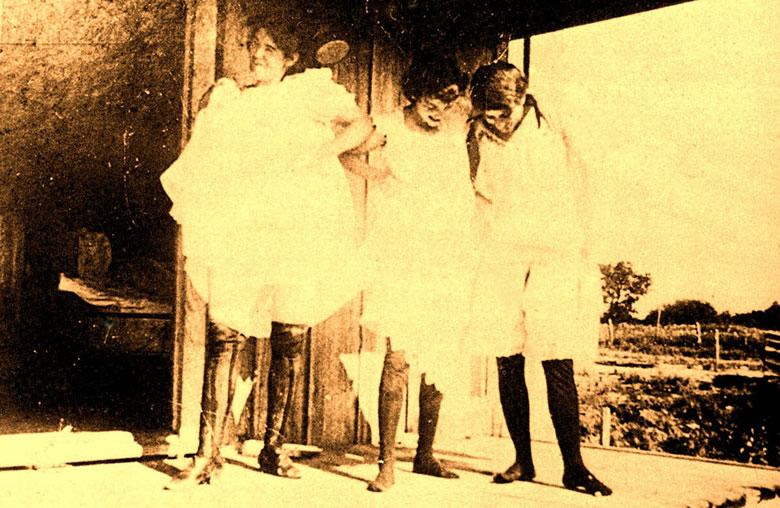
On one block, archeologists uncovered
the detached kitchen in what had been the Susan Morgan
boarding house. Among the fairly dense array of artifacts
strewn across its dirt floor, investigators found a
small ash pit containing a cache of ammunition and sewing
supplies.
Click images to enlarge
|
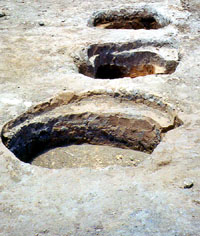
Privies were often placed along the
back of property lots, near alleyways. In Austin, unlike
larger cities such as San Antonio or Houston that had
strict sanitation ordinances, most privies were shallow,
unlined, and foul-smelling affairs that required frequent
clean-out, or replacement. Here, a line of shallow,
excavated privies is shown. These privies served the
residents at the Susan Morgan boarding house.
|
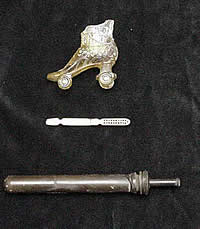
Artifacts from a privy located behind
the site of a tenement building on the City Hall block.
From top to bottom, a decorative glass roller skate,
a bone make-up brush, and a syringe. Photo courtesy
Hicks & Co.
|
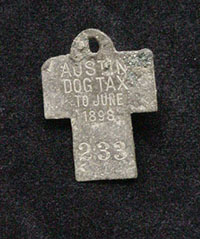
This 1898 dog tag was found next
to a brick foundation pier from a small rental house.
In 1896, the house was occupied by two Black women.
In 1905, the house was a saloon operated by Candido
Dellana.
|
|
In 1876, the Austin Daily Statesman reported
that two women arrested for keeping a brothel had threatened to
divulge who their frequent clients were. The article playfully added
that "several high-toned gentlemen [were] quaking in their
boots." The women were denizens of Austin's Guy Town, the infamous
red-light district that blossomed during the last quarter of the
nineteenth century. Their clients were city council members, legislators,
and businessmen who tacitly supported business in Guy Town through
their continued patronage. Their stories unfold along with those
of others who helped build Austin in the nineteenth and twentieth
centuries.
The saga of Guy Town is the story of Tom Callahan,
a rowdy young police officer in 1884 who became involved with a
prostitute and found himself on the wrong side of the law one too
many times. It is the story of Mollie King, a dishonored woman in
her twenties who struggled to live down the shame of an out-of-wedlock
child. The end to that struggle came one spring morning in 1912,
when she was murdered by her lover behind the Piper Saloon. It is
the story of a former slave named Caroline Robinson, who purchased
property in 1867 along Second Street where she lived quietly with
her white lover and their child. And it is also the story of the
enterprising Schneider family, the saloon-owning Metz clan, the
Italian immigrant Cuneo family, and the debt-riddled Bozeths. Indeed,
between 1876 and 1913, the neighborhood known as Guy Town served
as the backdrop for countless human dramas involving not just prostitutes,
gamblers, and drinkers, but laundresses, housekeepers, lawyers,
engineers, junk dealers, blacksmiths, masons, and saloon porters.
All of these formed the small First Ward community located near
the river, just west of Congress Avenue; today this area has given
way to high-rise office buildings and apartments.
Excavations Span Four City Blocks
Hicks & Company has been conducting archeological
investigations of Guy Town as part of Austin's downtown redevelopment
initiative. Excavations have spanned four city blocks, including
the block where the city plans to build its new city hall. Integrating
detailed historical research with archeological investigations,
the project has provided unique insights not only into one of the
more notorious aspects of the city's past, but also into a residential
neighborhood peopled by an ethnically and economically diverse population.
Investigations have uncovered over 100 features pertaining to both
businesses and residences in the project area. Types of features
include foundations, wells, cisterns, privies, trash pits, and yardscape
features. These features were built and shared by a dynamic community
of individuals whose ethnic and economic backgrounds were as diverse
as their various trades.
In an on-site lab, archeologists processed
more than 10,000 artifacts representing not only the business
of Guy Town but also the everyday lives of hundreds of residents
who made this neighborhood their home. The personal effects
they left behind serve as a compelling document of their unwritten
history. A dog license from 1898 is a poignant reminder of
a long-lost pet; an axe head and a tatting needle illustrate
the type of daily work performed by one-time residents; a
spur recalls the mythic cattle ranching industry; broken and
discarded toys attest to the sorts of games children played;
and a conch shell, perhaps a memento from a trip to the sea,
gives us a sense of someone's decorative aesthetic. Alongside
these more-mundane symbols of everyday life lie the artifacts
of red light activities and the business of Guy Town—devices
used for women's birth control, fancy cut-glass goblets, bar
tokens, dice, and hundreds of empty beer, wine, and whisky
bottles. Ongoing research and analysis will continue to bring
the Guy Town community into focus and, in the process, create
a fascinating collage of a nineteenth-century urban neighborhood.
Credits
The Guy Town webpage was written by Rachel Feit,
staff archeologist with Hicks & Company of Austin, Texas.
|
|
Guy Town was Austin's infamous red-light district
that flourished in the downtown area during the last
quarter of the nineteenth century.
|
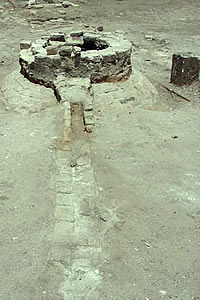
The Bozeth Cistern. Located next
to the front entrance of the house, the cistern was
likely covered by a front porch. Water from the roof
of the house was collected through a pipe that ran into
the opening on top of the cistern. An overflow spout
directed excess water into the yard. Photo courtesy
Hicks & Co.
|
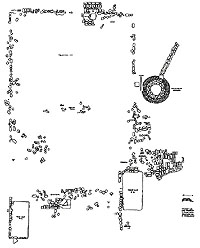
Brick foundation for the Bozeth House,
located on the corner of San Antonio and Second Street.
The Bozeth family worked as brick masons and occupied
this house for close to seventy years.
|
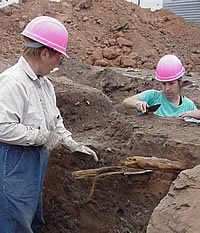
Archeologists from Hicks & Co. excavate
a privy. The odd, many-cornered shape of this pit suggests
that the privy shaft was moved around a number of times
before it was finally covered over. Photo courtesy Hicks
& Co.
|
|
